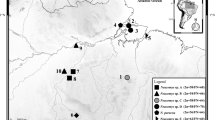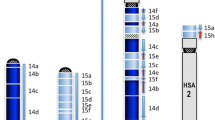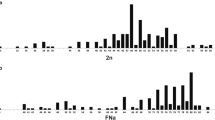Abstract
The Neotropical monkey genus Aotus (owl or night monkeys) are among the most karyological diverse primates of the world. Their diploid numbers range from 2n = 46 to 58, but even owl monkeys with the same diploid number may have radically different karyotypes. This karyotypic variability has provided precious information for taxonomists and has a potential for aiding phylogenetic analysis of these primates. However, up to now only three out of 11 species have been analyzed with molecular cytogenetic methods. Here, we report on a fourth species, A. infulatus. Females have a diploid number of 2n = 50 while males, due to a Y/autosome translocation, have 49 chromosomes. We provide a complete map of chromosome homology between humans and A. infulatus. Comparisons with previous reports allowed us to propose a putative ancestral karyotype of the genus (2n = 52) and to deduce the rearrangements that were involved in the origin of each species chromosome complement. Integration of chromosome painting and banding analysis suggests at least three chromosomes have evolutionary new centromeres that appeared during the divergence of these four owl monkey species.




Similar content being viewed by others
References
Araújo NP, Loss AC, Cordeiro-Junior DA, da Silva KR, Leite YLR, Svartman M (2014) New karyotypes of Atlantic tree rats, genus Phyllomys (Rodentia: Echimyidae). Genome 57:1–8
Capozzi O, Archidiacono N, Lorusso N, Stanyon R, Rocchi M (2016) The 14/15 association as a paradigmatic example of tracing karyotype evolution in New World monkeys. Chromosoma 125:747–756
de Oliveira EHC, Neusser M, Müller S (2012) Chromosome evolution in New World monkeys (Platyrrhini). Cytogenet Genome Res 137:259–272
Dumas F, Bigoni F, Stone G, Sineo L, Stanyon R (2005) Mapping genomic rearrangements in titi monkeys by chromosome flow sorting and multidirectional in-situ hybridization. Chromosome Res 13:85–96
Hershkovitz P (1949) Mammals of northern Colombia. Preliminary report no. 4: Monkeys (primates) with taxonomic revisions of some forms. Proc US Natl Mus 98:323–427
Hershkovitz P (1983) Two new species of night monkeys, genus Aotus (Cebidae, Platyrrhini): a preliminary report on Aotus taxonomy. Am J Primatol 4:209–243
Howell WM, Black DA (1980) Controlled silver-staining of nucleolus organizer regions with a protective colloidal developer: A 1-step method. Experientia 36:1014–1015
Kiesling NMJ, Yi SV, Xu K, Sperone FG, Wildman DE (2014) The tempo and mode of New World monkey evolution and biogeography in the context of phylogenomic analysis. Mol Phylogenet Evol 82:386–399
Ma NSF (1981) Chromosome evolution in the owl monkey, Aotus. Am J Phys Anthropol 54:293–303
Ma NSF, Aquino R, Collins WE (1985) Two new karyotypes in the Peruvian owl monkey (Aotus trivirgatus). Am J Primatol 9:333–341
Ma NSF, Elliott MW, Morgan L, Miller A, Jones TC (1976) Translocation of Y chromosome to an autosome in the Bolivian owl monkey, Aotus. Am J Phys Anthropol 45:191–202
Menezes AN, Bonvicino CR, Seuánez HN (2010) Identification, classification and evolution of owl monkeys (Aotus, Illiger 1811). BMC Evol Biol 10:248
Mudry MD, Nieves M, Bolzán AD (2007) Chromosomal localization of the telomeric (TTAGGG)n sequence in eight species of New World primates (Neotropical primates, Platyrrhini). Cytogenet Genome Res 119:221–224
Osterholz M, Walter L, Roos C (2009) Retropositional events consolidate the branching order among New World monkey genera. Mol Phylogenet Evol 50:507–513
Perelman P, Johnson WE, Roos C, Seuánez HN, Horvath JE, Moreira MAM, Kessin B, Pontius J, Roelke M, Rumpler Y, Schneider MPC, Silva A, O’Brien SJ, Pecon-Slattery J (2011) A molecular phylogeny of living primates. PLoS Genet 7(3): e1001342
Pieczarka JC, Barros RMS, Faria FM Jr, Nagamachi CY (1993) Aotus from the southwestern Amazon region is geographically and chromosomally intermediate between A. azarae boliviensis and A. infulatus. Primates 34:197–204
Pieczarka JC, Nagamachi CY (1988) Cytogenetic studies of Aotus from eastern Amazonia: Y/autosome rearrangement. Am J Primatol 14:255–263
Prakhongcheep O, Chaiprasertsri N, Terada S, Hirai Y, Srikulnath K, Hirai H, Kogo A (2013) Heterochromatin blocks constituting the entire short arms of acrocentric chromosomes of Azara’s owl monkey: formation processes inferred from chromosomal locations. DNA Res 20:461–470
Ruiz-Herrera A, García F, Aguilera M, Garcia M, Fontanals MP (2005) Comparative chromosome painting in Aotus reveals a highly derived evolution. Am J Primatol 65:73–85
Seabright M (1971) A rapid banding technique for human chromosomes. Lancet 2:971–972
Springer MS, Meredith RW, Gatesy J, Emerling CA, Park J, Rabosky DL, Stadler T, Steiner C, Ryder OA, Janecka JE, Fisher CA, Murphy WJ (2012) Macroevolutionary dynamics and historical biogeography of primate diversification inferred from a species supermatrix. PLoS One 7(11): e49521
Stanyon R, Bigoni F, Slaby T, Muller S, Stone G, Bonvicino CR, Neusser M, Seuánez HN (2004) Multi-directional chromosome painting maps homologies between species belonging to three genera of New World monkeys and humans. Chromosoma 113:305–315
Stanyon R, Bonvicino CR, Svartman M, Seuánez HN (2003) Chromosome painting in Callicebus lugens, the species with the lowest diploid number (2n=16) known in primates. Chromosoma 112:201–206
Stanyon R, Galleni L (1991) A rapid fibroblast culture technique for high resolution karyotypes. Boll Zool 58:81–83
Stanyon R, Garofalo F, Steinberg ER, Capozzi O, Di Marco S, Nieves M, Archidiacono N, Mudry MD (2011) Chromosome painting in two genera of South American monkeys: species identification, conservation, and management. Cytogenetic Genome Res 134:40–50
Sumner AT (1972) A simple technique for demonstrating centromeric heterochromatin. Exp Cell Res 75:305–306
Torres OM, Enciso S, Ruiz F, Silva E, Yunis I (1998) Chromosome diversity of the genus Aotus from Colombia. Am J Primatol 44:255–275
Acknowledgements
This work was supported by a grant from Conselho Nacional de Desenvolvimento Científico e Tecnológico (CNPq Process 4072622013-0) to MS and RS and a PRIN (Programmi di Ricerca Scientifica di Rilevante Interesse Nazionale: 2012TZF8HL_003) to RS. NPA was the recipient of a doctoral fellowship from the Coordenação de Aperfeiçoamento de Pessoal de Nível Superior (CAPES).
Author information
Authors and Affiliations
Corresponding author
Ethics declarations
All procedures performed in studies involving animals were in accordance with the ethical standards of the institution or practice at which the studies were conducted.
This article does not contain any studies with human participants performed by any of the authors.
Conflict of Interest
The authors declare that they have no conflict of interest.
Rights and permissions
About this article
Cite this article
Araújo, N.P., Stanyon, R., do Socorro Pereira, V. et al. Interspecific Chromosome Painting Provides Clues to the Ancestral Karyotype of the New World Monkey Genus Aotus. J Mammal Evol 26, 283–290 (2019). https://doi.org/10.1007/s10914-017-9403-z
Published:
Issue Date:
DOI: https://doi.org/10.1007/s10914-017-9403-z




